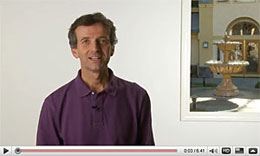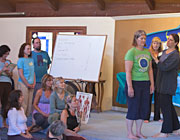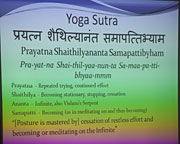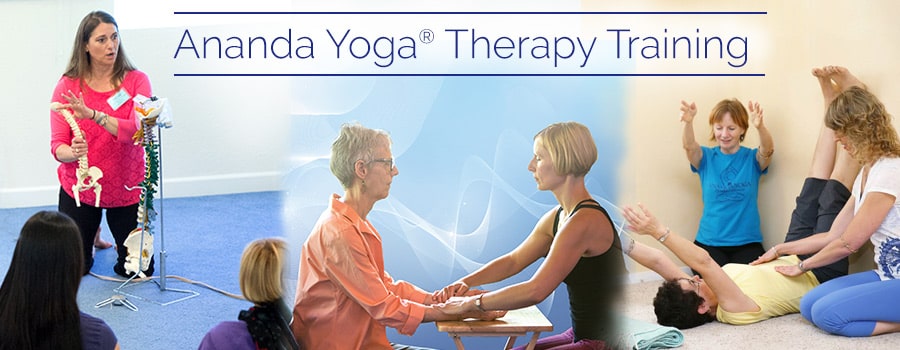[PLEASE NOTE—The following information pertains ONLY to those who are taking this course as part of Ananda Yoga Therapy Training..
Complete list of all the IAYT Competencies for Yoga Therapy Trainees]
SYLLABUS
Ananda Meditation® Teacher Training Level 1
We are not currently accepting new students in the Ananda Yoga Therapy Training
Course Contact Hours: 53 (Residential)
Prerequisite
Students need to be meditating daily for a minimum of ½ hr with the technique the course faculty sends them through MP3 with written instructions on how to follow. In most cases, students sign up for this course 2-3 months ahead of time and therefore have the time to do this. In some cases, we’ll accept students 1-2 weeks prior to class if necessary.
Teaching Format
This is a 12-day residential course, which includes a combination of lecture, discussion, experiential, practice teaching of the meditation technique, and student teachings. On three afternoons of the course we have the students teach each other, with supervision of qualified faculty. After that, one afternoon of the course, the students teach volunteer clients, with individual supervision in which at the end each student receives feedback from a senior faculty on how they did and how they can improve. There are two sessions in which each student gives a presentation on meditation, with an assigned topic to talk about. At the second presentation, each student receives feedback by a senior faculty on how they did, and how they can improve. Also each student has to submit a written exam at the end of the training.
Course Description
This course is focused primarily on teaching the students how to teach an ancient, universal technique of meditation, from India, but the training also includes many aspects of meditation, such as how to sit comfortably for meditation, how to guide through a variety of pranayama techniques, before meditation, how to lead affirmations and visualizations to aid meditation, and a variety of other related aspects, that can be helpful to the teaching of meditation.
This 12-day training provides a solid foundation for teaching both the science and the art of meditation. Our curriculum includes classes and workshops on these topics:
- How to teach basic meditation skills to anyone
- The essential connection of meditation and energy
- Concentration techniques for quieting the mind
- Patanjali’s Eight Limbed Yoga
- How to teach breathing exercises, visualizations, walking meditations
- Simple yoga stretches to prepare for meditation
- How to sit comfortably for meditation
- Opening the heart and developing devotion
- The scientific effects of meditation on the brain and nervous system
- Meditation and prayer
- Meditation and intuition
- Spiritual counseling suggestions
- How to set up and market your classes
The spectrum of techniques we share during the training are based on the highest ancient yogic practices of India. Students practice and teach extensively during the training, with ample guidance and feedback from faculty. Our curriculum prepares students to teach meditation skills to anyone. We consider this to be one of the key skills of a yoga therapist.
In addition to inspiring classes offered by some of Ananda's finest and most experienced meditation teachers, students participate in daily meditations and Ananda Yoga® practices, and receive a comprehensive teaching manual. Graduates receive a Certificate of Completion and credits toward Level 2 yoga teacher certification and Ananda Yoga Therapy Training. Meditation Teacher Training is offered three times in 2018. Please see attached schedule for the general flow of the training.
Faculty: Ananda Ministers:
Nayaswami Diksha McCord, BSc, BFA, Level 2 Ananda Yoga & Meditation Teacher
Nayaswami Gyandev McCord, PhD, E-RYT 500, Director of Ananda Yoga Teacher Training, Kriyacharya
Learning Objectives
Students will know:
- What meditation is and what it is not;
- How to get comfortable for a silent, sitting meditation, and how to teach students to do the same;
- How to use the breath to calm the body and mind;
- Concentration techniques to overcome mental restlessness;
- How to use affirmations, visualization, and walking meditations;
- How to open the heart chakra and develop one’s feeling nature;
- How to use music as an aid to meditation;
- Effective presentation skills and how to overcome stage fright;
- How to become a truly dynamic teacher;
- How to organize and market your classes.
Required Texts/Reading Materials
Included as a part of the course is a 150-page Meditation Teacher’s Manual. Students are assigned required reading assignments from the manual’s Table of Contents.
Reading Assignments
MTT I Reading Assignments from Manual
| Wednesday | Section I 1.1 | The Basics of Meditation (1–8) |
| Section IV. | What is a Yuga? (114-116) | |
| Thursday | Section I 1.1 | The Basics of Meditation (9–13) |
| Friday | Section III. | Different States of Consciousness (86-89) |
| Levels of Consciousness | ||
| Benefits and Goals of Meditation (11-12, 96) | ||
| Monday | Section I 1.3 | Obstacles to Meditation (34-35) |
| Section II 2.1 | Energy and Yoga (76-81) | |
| Section IV | The Eight-Fold Path of Meditation (103-106) | |
| Tuesday | Section I 1.2 | Guided Meditations (16-30) |
| Section I 1.6 | The 10 basic steps of teaching Meditation (73) | |
| Section III | Working with Affirmations (96-100) | |
| Wednesday | Section I. 1.4 | Devotion and Music (40-51) |
| Thursday | Section I 1.3 | Application (31-39) |
| Section I 1.6 | How to Teach Meditation (56-64) |
Ananda Meditation Teacher Training Manual Table of Contents
| Section I – Teaching Meditation | 1 |
| 1.1— The Basics of Meditation | 1 |
| Meditation is | 1 |
| What Meditation is NOT | 2 |
| Why Meditate? | 3 |
| The Essence of Joy | 4 |
| Getting Comfortable for a Seated Meditation | 5 |
| Practical Hints for Meditation | 8 |
| The Hong-Sau Technique | 9 |
| How to Meditate with the Hong-Sau Technique | 9 |
| Preparation: Relaxation | 9 |
| The Hong-Sau Technique: Concentration | 10 |
| Meditation: Expansion | 10 |
| Enhancing Mantra (Hong-Sau) Meditation Practices | 11 |
| Benefits of Meditation | 11 |
| Goals of Meditation | 12 |
| Why Hong-Sau Works | 13 |
| 1.2 Guided Meditations | 16 |
| Guided Meditations on the Eight Aspects of God | 21 |
| Walking Meditations | 29 |
| 1.3 Application | 31 |
| Bringing Meditation Into Daily Life | 31 |
| The Importance of Good Company (“Satsang”) | 32 |
| Meditation Questionnaire — Taking it Home With You | 34 |
| Obstacles to Meditation | 34 |
| Signs of Spiritual Progress | 36 |
| How to Take Seclusion | 38 |
| A Sample Day of Seclusion | 39 |
| 1.4 Devotion and Music | 40 |
| The Devotion aspect of meditation | 40 |
| Developing Devotion | 42 |
| Devotion—Guided Introspection | 44 |
| Intuitive Guidance | 45 |
| What is Chanting? | 46 |
| 1.5 Guided Prayers | 52 |
| Effective Prayer | 52ii |
| Paramhansa Yogananda’s Healing Prayer Procedures | 53 |
| Sample Prayers | 54 |
| 1.6 How to Teach Meditation | 56 |
| How to Be an Inspiring Teacher | 56 |
| How to Prepare for a Class/Lecture/Workshop | 58 |
| Suggestions On How to Teach Meditation | 60 |
| Overcoming Nervousness and Stage Fright | 63 |
| For Nervousness in General | 63 |
| Questions Often Asked About Meditation | 65 |
| Suggestions for a Four-Week “How to Meditate” Class Series | 68 |
| Teaching Meditation & Stress Management in the Corporate World | 71 |
| The 10 Basics Steps of Teaching Meditation | 73 |
| A Short Version for Teaching Meditation | 73 |
| ‘The Art of Counseling” | 74 |
| Section II – Physical Aids to Meditation | 76 |
| 2.1—Energy and Yoga | 76 |
| Basic Principles of The Energization Exercises | 76 |
| How To Teach or Lead Energization | 77 |
| What Is Breath? | 78 |
| Pranayama (Breathing Exercises) | 81 |
| The Circle of Joy Breath | 83 |
| The 6 “Superconscious Living” Exercises | 84 |
| Seated Yoga Stretches Before Meditation | 85 |
| Section III – Working with Consciousness | 86 |
| 3.1—Levels of Consciousness | 86 |
| Different States of Consciousness | 86 |
| Levels of Consciousness | 87 |
| Introspection and Journal Writing Suggestions | 90 |
| Spiritual Introspection Questions | 92 |
| Kundalini Power and How to Work With It | 93 |
| Goal(s) and Benefits of Meditation | 96 |
| Working with Affirmations | 96 |
| How to Guide Affirmations and Visualizations | 98 |
| Samadhi (poem by Paramhansa Yogananda) | 101 |
| Section IV – Tools of Yoga and Meditation | 103 |
| 4.1—The Eight-Fold Path of Meditation | 103 |
| Patanjali’s Ashtanga Yoga | 103 |
| Yama (Control Or Moral Restraint) | 103iii |
| Niyama (Non-Control Or Moral Requirement) | 104 |
| Asana (Posture) | 104 |
| Applying The Attitudes Of Patanjali’s Yamas & Niyamas To Meditation | 106 |
| Creating The Habit Of Meditation | 107 |
| Meditation Habit Changing Worksheet | 108 |
| Sadhana Chart (Sample) | 109 |
| The Different Paths Of Yoga — and — What Is Yoga? | 110 |
| Taking It Home With You | 112 |
| Suggested Books And CDs | 113 |
| What is a Yuga? | 114 |
| Section V – Healing and Meditation | 117 |
| Dealing with Stress | 117 |
| Twenty One Effective Ways of Dealing with Stress | 118 |
| Dealing with the Dark Forces | 119 |
| Six–Point Plan for Perfect Health | 122 |
| Healing for The Spirit | 123 |
| Living a Balanced Life | 124 |
| Section VI – Research on Meditation | 127 |
| 6.1 Research on Stress and Meditation | 127 |
| The High Cost of Stress | 127 |
| Effectiveness of Meditation in Reducing Stress | 128 |
| Engineered for Divinity — “The Brain” by Peter van Houten, M.D. | 132 |
| Meditation and Emotions: Their Impact on Your Brain and Health | 137 |
| Section VII – Marketing Your Classes | 142 |
| Marketing Your Classes | 142 |
| Marketing Tools for the Meditation Teacher | 144 |
| Sources for Various Meditation Props and Gear | 145 |
| Section VIII | 146 |
| 8.1—Secrets of Meditation | 146 |
| 8.2—Secrets of Inner Peace | 149 |
| 8.3—Meditation for Starters | 150 |
Subject Matter/IAYT Competencies Covered
Section 1. Yoga Foundations
Category 1.1. Yoga Teachings and Philosophy
1.1.1 Familiarity with the evolution of the teachings and philosophy of the yoga
tradition and its relevance and application to yoga therapy, including teachings
from Vedic and post-Vedic periods, Samkhya,Yoga,Tantra, and Ayurveda.
Examples of concepts and models from the above teachings and philosophy
relevant to yoga therapy, include but are not limited to,
a. tanmatra/bhuta/indriya (subtle element/gross elements/senses);
b. purusha/prakrti (consciousness/material world);
c. pancamaya kosha (dimensions of the human system);
e. duhkha (suffering/discomfort).
Category 1.2. Yoga and the Mind
1.2.1 Knowledge of yoga perspectives on the structure, states, functioning, and conditions of the mind, including, but not limited to,
1.2.1.1 drashtr (seer), drshya (seen);
1.2.1.2 antahkarana citta (consciousness), buddhi (intellect), ahamkara (ego), manas (mind);
1.2.1.3 citta vrtti (activities of the mind), citta parinama (structural changes in the mind), vyutthana/nirodha (mind's potential for distraction and focus);
1.2.1.4 artha (cognition), bhava (mood), svabhava (inborn nature), vasana (residue of experience), samskara (conditioned pattern of thinking and behavior); and
1.2.1.5 states of mind: mudha (stupefied/dull), kshipta (disturbed), vikshipta (alternating between distraction and focus), ekagrata (one-pointed), nirodha (focus enveloped/held/ restrained), vaishvanara (waking), taijasa (dream), prajña (deep sleep), turiya (beyond).
1.2.2 Knowledge of yoga perspectives on distracted/disturbed conditions of mind and their expressions as expressed in such texts as the Yoga Sutras, the Bhagavad Gita, and other texts, including but not limited to,
1.2.2.1 klesha (affliction);
1.2.2.2 lobha, krodha, and moha (greed, anger, attachment);
1.2.2.3 duhkha and daurmanasya (suffering/discomfort and negative attitude/thinking), sarupyam (identification with the contents of the mind or seer taking the same form as the mind); and
1.2.2.4 antaraya (obstacles to progress in yoga).
Section 2. Biomedical and Psychological Foundations
Category 2.1. Anatomy and Physiology
2.1.1 Knowledge of human anatomy and physiology, including all major systems of
the body and their interrelationships, as relevant to the work of a yoga therapist.
Category 2.3. Psychology and Mental Health
2.3.1 Basic knowledge of commonly occurring mental health conditions— from psychological distress to psychiatric conditions—their symptoms, and common approaches/interventions, as they relate to the work of a yoga therapist.
2.3.2 Basic knowledge of psychological concepts and terminology, including mood,
cognition, behavior, and personality, as relevant to the work of a yoga therapist.
Category 2.4. Additional Knowledge
2.4.1 Familiarity with models of human development, including developmental stages, lifecycles, and personality, and their importance to medical and psychological health and well-being.
2.4.2 Familiarity with the influence of familial, social, cultural, and religious
conditioning on mental and medical perspectives of health and healing.
Category 2.5. Body and Mind Integration
2.5.1 Knowledge of the interaction of the body, breath, mind, intellect, and emotions
in health and well-being.
Section 3. Yoga Therapy Tools and Therapeutic Skills
Category 3.1. Yoga Therapy Tools
3.1.1 In-depth knowledge of the application of yama and niyama.
3.1.2 In-depth knowledge of the range of yoga practices and their potential therapeutic effects for common conditions Practices may include, but are not limited to,
3.1.2.1 asana (postures);
3.1.2.2 pranayama (regulated breathing);
3.1.2.3 meditation and relaxation techniques such as bhavana (visualization), mantra (recitation),
3.1.2.4 vihara (lifestyle modifications) including basic yogic dietary concepts.
3.1.3 In-depth knowledge of contraindications of yoga practices for specific conditions and circumstances.
Category 3.2. Basic Principles of the Therapeutic Relationship
3.2.1. In-depth knowledge of, and observed capacity for, well-developed communication skills: listening, presence, directive and non-directive dialogue.
3.2.2. Demonstrated ability to recognize, adjust, and adapt to specific client/student needs in the evolving therapeutic/professional relationship.
3.2.3. Demonstrated ability to recognize and manage the subtle dynamics inherent in the therapist/client relationship.
3.2.4. In-depth Knowledge of the scope of practice of yoga therapy and how to assess the need for referral to other professional services.
Category 3.3. Principles and Skills for Educating Clients/Students
3.3.1. In-depth knowledge of and demonstrated ability to implement effective teaching methods, adapt to unique styles of learning, provide supportive and effective feedback, acknowledge the client's/student's progress, and cope with unique difficulties/successes.
3.3.2. In-depth knowledge of and demonstrated ability to transmit the value of self-awareness and self- responsibility throughout the therapeutic process.
3.3.3. In-depth knowledge of and demonstrated ability to develop and adjust appropriate practice strategies to the client/student.
Category 3.4. Principles and Skills for Working with Groups
3.4.1. Basic knowledge of and demonstrated ability to design, implement, and evaluate group programs.
3.4.2. Familiarity with group dynamics and techniques, including communication skills, time management, and the establishment of priorities and boundaries, as well as techniques to address the specific needs of individual participants, to the degree possible in a group setting.
Section 5. Professional Practice
Category 5.1. Ethical Principles
5.1.1 In-depth knowledge of yoga practices and methods for self-inquiry related to establishing, practicing, and maintaining ethical principles.
5.1.2 In-depth knowledge of generally accepted ethical principles of health care codes of conduct and yoga’s ethical principles.
5.1.3 Demonstrated ability to apply knowledge of generally accepted ethical principles and related concepts from the yoga tradition to professional interactions and relationships.
5.1.4 In-depth knowledge of the scope of practice of yoga therapy, resulting in the demonstrated ability to discern the need for referral to other modalities.
5.1.5 Knowledge of the extent of one's own individual training, skills, and evolving experience in yoga therapy, and knowledge of the importance of practicing within such parameters.
Category 5.2. Legal, Regulatory, and Business Issues Pertaining to Yoga Therapy
5.2.2 Basic knowledge of business practices relevant to the work of a yoga therapist, including record keeping, planning, and financial management.
Category 5.4. Personal and Professional Development and Continuing Education
5.4.1 Knowledge of the fundamental value of ongoing personal practice, long-term mentorship, and skills maintenance/development through continuing education.
5.4.2 Knowledge of when and how to seek advice and support for case consultation, educational advancement, and personal practice.
Course Completion Requirements
Students have demonstrated understanding of course learning objectives by their supervised practicum, attendance at all lectures, participation in practice teaching & team-teaching sessions, and completion of 4 short talks during the program. In addition, the completion of reading assignments and the final written exam are required.
Ananda Yoga Therapy Training
- Overview
- Flow Chart of Ananda Yoga® Therapy Training Courses
- Course Syllabi
- Tuition Costs
- Ananda Yoga® Therapy Training Courses Scheduled
- Frequent Questions
- Instructors
- Apply for Level 1
- Student Handbook with Costs
- Bridge to Ananda Yoga
Upcoming Courses in date order
- Restorative Ananda Yoga® Teacher Training - In Person
- Ananda Yoga® Advanced Training: Therapeutic Yoga for Seniors and Bone Strength
- Ananda Yoga® Assistantship
- Bhagavad Gita Retreat
- The Essence of the Yoga Sutras According to Paramhansa Yogananda
- Ananda Meditation® Teacher Training - In Person
- Advanced Pranayama
- Ananda Yoga® Therapy Training: Principles
- Ananda Yoga® Therapy Training: Musculoskeletal–1
- Ananda Yoga® Therapy Training Online: Ayurveda
- Ananda Yoga® Therapy Training Online: Health Challenges–1
- Ananda Meditation® Solutions
- Ananda Spiritual Counseling® Training - In Person
- Ananda Yoga® Therapy Training: Musculoskeletal–2
- Ananda Yoga® Therapy Training Online: Health Challenges–2
- Ananda Yoga® Therapy Training: Psychology and Mental Health
- Ananda Yoga® Therapy Training: Holistic Health Therapist Training
Nursing CEU Eligible: details coming

How to Choose a
Yoga Teacher Training Program

“My 4 weeks of Ananda Yoga Teacher Training was one of the most fulfilling and spiritually transforming periods in my life. All of the faculty, along with the entire Ananda community, were very supportive and nurturing.” – R. F., Lake Bluff, IL.

Testimonial for the Ananda Yoga Therapy Training Program
“The program is all embracing ˜ asana, ayurveda, chakras, special health issues touching on body, mind, and spirit. The instructors were wonderful, knowledgeable, supportive, and enthusiastic.” – T.C., CA.







The yoga therapy components of these courses are based on our accreditation by IAYT, not derived from our status as an RYS with Yoga Alliance Registry.


CONNECT
14618 Tyler Foote Rd
Nevada City, California 95959
Toll free 800-346-5350
Outside US 530-478-7518
LEARN MORE
SUBSCRIBE
Receive uplifting emails with inspirational content and news about our retreat programs, travels, and trainings.
















